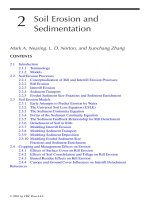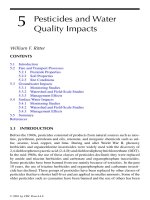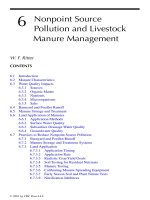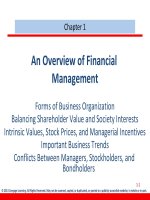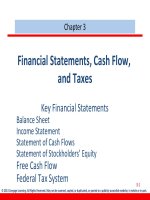Finance management cengage 2013 chapter 016
Bạn đang xem bản rút gọn của tài liệu. Xem và tải ngay bản đầy đủ của tài liệu tại đây (117.91 KB, 34 trang )
Chapter 16
Working Capital Management
Alternative Working Capital Policies
Cash Management
Inventory and A/R Management
Trade Credit
Bank Loans
16-1
© 2013 Cengage Learning. All Rights Reserved. May not be scanned, copied, or duplicated, or posted to a publicly accessible website, in whole or in part.
Working Capital Terminology
•
•
Working capital: current assets.
•
Net operating working capital: current assets minus
(current liabilities less notes payable).
•
Current assets investment policy: deciding the level
of each type of current asset to hold, and how to
finance current assets.
•
Working capital management: controlling cash,
inventories, and A/R, plus short-term liability
management.
Net working capital: current assets minus current
liabilities.
16-2
© 2013 Cengage Learning. All Rights Reserved. May not be scanned, copied, or duplicated, or posted to a publicly accessible website, in whole or in part.
Selected Ratios for SKI Inc.
SKI
Ind Avg
Current ratio
1.75x
2.25x
Debt/Assets
58.76%
50.00%
Turnover of cash & securities
16.67x
22.22x
Days sales outstanding
45.63
32.00
Inventory turnover
4.82x
7.00x
Fixed assets turnover
11.35x
12.00x
Total assets turnover
2.08x
3.00x
Profit margin
2.07%
3.50%
Return on equity
10.45%
21.00%
16-3
© 2013 Cengage Learning. All Rights Reserved. May not be scanned, copied, or duplicated, or posted to a publicly accessible website, in whole or in part.
How does SKI’s current assets investment policy
compare with its industry?
•
Current assets investment policy is reflected in the
current ratio, turnover of cash and securities,
inventory turnover, and days sales outstanding.
•
These ratios indicate SKI has large amounts of
working capital relative to its level of sales.
•
SKI is either very conservative or inefficient.
16-4
© 2013 Cengage Learning. All Rights Reserved. May not be scanned, copied, or duplicated, or posted to a publicly accessible website, in whole or in part.
Is SKI inefficient or conservative?
•
A conservative (relaxed) policy may be appropriate
if it leads to greater profitability.
•
However, SKI is not as profitable as the average firm
in the industry.
– This suggests the company has excessive current
assets.
16-5
© 2013 Cengage Learning. All Rights Reserved. May not be scanned, copied, or duplicated, or posted to a publicly accessible website, in whole or in part.
Working Capital Financing Policies
•
Moderate: Match the maturity of the assets with
the maturity of the financing.
•
Aggressive: Use short-term financing to finance
permanent assets.
•
Conservative: Use permanent capital for
permanent assets and temporary assets.
16-6
© 2013 Cengage Learning. All Rights Reserved. May not be scanned, copied, or duplicated, or posted to a publicly accessible website, in whole or in part.
Moderate Financing Policy
$
Temp. C.A.
S-T
Loans
Perm C.A.
Fixed Assets
L-T Fin:
Stock,
Bonds,
Spon. C.L.
Years
Lower dashed line would be more aggressive.
16-7
© 2013 Cengage Learning. All Rights Reserved. May not be scanned, copied, or duplicated, or posted to a publicly accessible website, in whole or in part.
Conservative Financing Policy
$
Marketable
securities
Perm C.A.
Zero S-T
Debt
L-T Fin:
Stock,
Bonds,
Spon. C.L.
Fixed Assets
Years
16-8
© 2013 Cengage Learning. All Rights Reserved. May not be scanned, copied, or duplicated, or posted to a publicly accessible website, in whole or in part.
Cash Conversion Cycle
•
The cash conversion cycle focuses on the length of
time between when a company makes payments to
its creditors and when a company receives
payments from its customers.
Inventory
Average Payables
CCC = conversion + collection − deferral
period
period
period
16-9
© 2013 Cengage Learning. All Rights Reserved. May not be scanned, copied, or duplicated, or posted to a publicly accessible website, in whole or in part.
Cash Conversion Cycle
Inventory
Average Payables
CCC = conversion + collection − deferral
period
period
period
Payables
Days per year
Days sales
CCC =
+
− deferral
outstandin
g
Inventory turnover
period
365
+ 46 − 30
4.82
CCC = 76 + 46 − 30 = 92 days
CCC =
16-10
© 2013 Cengage Learning. All Rights Reserved. May not be scanned, copied, or duplicated, or posted to a publicly accessible website, in whole or in part.
Minimizing Cash Holdings
•
•
Use a lockbox
•
•
Synchronize inflows and outflows
Insist on wire transfers and debit/credit cards from
customers
Reduce need for “safety stock” of cash
– Increase forecast accuracy
– Hold marketable securities
– Negotiate a line of credit
16-11
© 2013 Cengage Learning. All Rights Reserved. May not be scanned, copied, or duplicated, or posted to a publicly accessible website, in whole or in part.
Cash Budget
•
Forecasts cash inflows, outflows, and ending cash
balances.
•
Used to plan loans needed or funds available to
invest.
•
Can be daily, weekly, or monthly, forecasts.
– Monthly for annual planning and daily for actual cash
management.
16-12
© 2013 Cengage Learning. All Rights Reserved. May not be scanned, copied, or duplicated, or posted to a publicly accessible website, in whole or in part.
SKI’s Cash Budget for January and February
January
February
Collections
$67,651.95
$62,755.40
Purchases
44,603.75
36,472.65
Wages
6,690.56
5,470.90
Rent
2,500.00
2,500.00
Total payments
$53,794.31
$44,443.55
Net cash flows
$13,857.64
$18,311.85
16-13
© 2013 Cengage Learning. All Rights Reserved. May not be scanned, copied, or duplicated, or posted to a publicly accessible website, in whole or in part.
SKI’s Cash Budget
Cash at start if no borrowing
Net cash flows
Cumulative cash
Less: Target cash
Surplus
January
February
$ 3,000.00
$16,857.64
13,857.64
18,311.85
$16,857.64
$35,169.49
1,500.00
1,500.00
$15,357.64
$33,669.49
16-14
© 2013 Cengage Learning. All Rights Reserved. May not be scanned, copied, or duplicated, or posted to a publicly accessible website, in whole or in part.
How could bad debts be worked into the cash
budget?
•
Collections would be reduced by the amount of the
bad debt losses.
•
For example, if the firm had 3% bad debt losses,
collections would total only 97% of sales.
•
Lower collections would lead to higher borrowing
requirements.
16-15
© 2013 Cengage Learning. All Rights Reserved. May not be scanned, copied, or duplicated, or posted to a publicly accessible website, in whole or in part.
Analyze SKI’s Forecasted Cash Budget
•
Cash holdings will exceed the target balance for
each month, except for October and November.
•
Cash budget indicates the company is holding too
much cash.
•
SKI could improve its EVA by either investing cash in
more productive assets, or by returning cash to its
shareholders.
16-16
© 2013 Cengage Learning. All Rights Reserved. May not be scanned, copied, or duplicated, or posted to a publicly accessible website, in whole or in part.
Why might SKI want to maintain a relatively high
amount of cash?
•
If sales turn out to be considerably less than
expected, SKI could face a cash shortfall.
•
A company may choose to hold large amounts of
cash if it does not have much faith in its sales
forecast, or if it is very conservative.
•
The cash may be used, in part, to fund future
investments.
16-17
© 2013 Cengage Learning. All Rights Reserved. May not be scanned, copied, or duplicated, or posted to a publicly accessible website, in whole or in part.
Inventory Costs
•
Types of inventory costs
– Carrying costs:
–
–
•
storage and handling costs,
insurance, property taxes, depreciation, and
obsolescence.
Ordering costs: cost of placing orders, shipping, and
handling costs.
Costs of running short: loss of sales or customer
goodwill, and the disruption of production schedules.
Reducing inventory levels generally reduces
carrying costs, increases ordering costs, and may
increase the costs of running short.
16-18
© 2013 Cengage Learning. All Rights Reserved. May not be scanned, copied, or duplicated, or posted to a publicly accessible website, in whole or in part.
Is SKI holding too much inventory?
•
SKI’s inventory turnover (4.82x) is considerably
lower than the industry average (7.00x).
– The firm is carrying a large amount of inventory per
dollar of sales.
•
By holding excessive inventory, the firm is
increasing its costs, which reduces its ROE.
– Moreover, this additional working capital must be
financed, so EVA is also lowered.
16-19
© 2013 Cengage Learning. All Rights Reserved. May not be scanned, copied, or duplicated, or posted to a publicly accessible website, in whole or in part.
If SKI reduces its inventory without adversely affecting
sales, what effect will this have on the cash position?
•
•
Short run: Cash will increase as inventory purchases
decline.
– This will reduce financing or target cash balance.
Long run: Company is likely to take steps to reduce its
cash holdings and increase its EVA.
– The “excess” cash can be used to make investments in
–
more productive assets such as plant and equipment
resulting in an increase in operating income increasing its
EVA.
Alternately, can distribute “excess” cash to its shareholders
through higher dividends or repurchasing shares resulting
in a lower cost of capital increasing its EVA.
16-20
© 2013 Cengage Learning. All Rights Reserved. May not be scanned, copied, or duplicated, or posted to a publicly accessible website, in whole or in part.
Do SKI’s customers pay more or less promptly
than those of its competitors?
•
•
SKI’s DSO (45.6 days) is well above the industry
average (32 days).
– SKI’s customers are paying less promptly.
SKI should consider tightening its credit policy in
order to reduce its DSO.
16-21
© 2013 Cengage Learning. All Rights Reserved. May not be scanned, copied, or duplicated, or posted to a publicly accessible website, in whole or in part.
Elements of Credit Policy
1. Credit Period: How long to pay? Shorter period
reduces DSO and average A/R, but it may
discourage sales.
2. Cash Discounts: Lowers price. Attracts new
customers and reduces DSO.
3. Credit Standards: Restrictive standards tend to
reduce sales, but reduce bad debt expense. Fewer
bad debts reduce DSO.
4. Collection Policy: How tough? Restrictive policy
will reduce DSO but may damage customer
relationships.
16-22
© 2013 Cengage Learning. All Rights Reserved. May not be scanned, copied, or duplicated, or posted to a publicly accessible website, in whole or in part.
Does SKI face any risk if it restricts its credit policy?
•
Yes, a restrictive credit policy may discourage sales.
– Some customers may choose to go elsewhere if they
are pressured to pay their bills sooner.
– SKI must balance the benefits of fewer bad debts
with the cost of possible lost sales.
16-23
© 2013 Cengage Learning. All Rights Reserved. May not be scanned, copied, or duplicated, or posted to a publicly accessible website, in whole or in part.
If SKI reduces its DSO without adversely affecting
sales, how would this affect its cash position?
•
Short run: If customers pay sooner, this increases
cash holdings. This will reduce financing or target
cash balance needed.
•
Long run: Over time, the company would hopefully
invest the cash in more productive assets, or pay it
out to shareholders. Both of these actions would
increase EVA.
16-24
© 2013 Cengage Learning. All Rights Reserved. May not be scanned, copied, or duplicated, or posted to a publicly accessible website, in whole or in part.
What is trade credit?
•
•
Trade credit is credit furnished by a firm’s suppliers.
•
Spontaneous, easy to get, but cost can be high.
Trade credit is often the largest source of shortterm credit, especially for small firms.
16-25
© 2013 Cengage Learning. All Rights Reserved. May not be scanned, copied, or duplicated, or posted to a publicly accessible website, in whole or in part.
